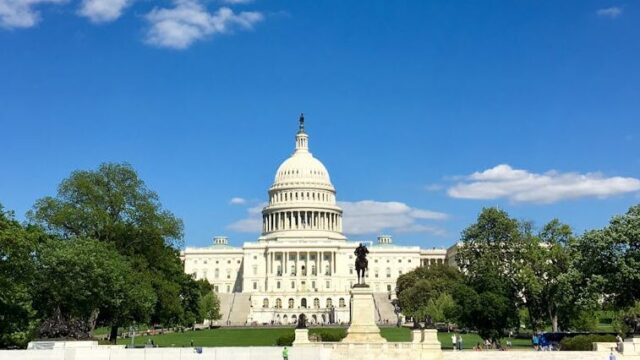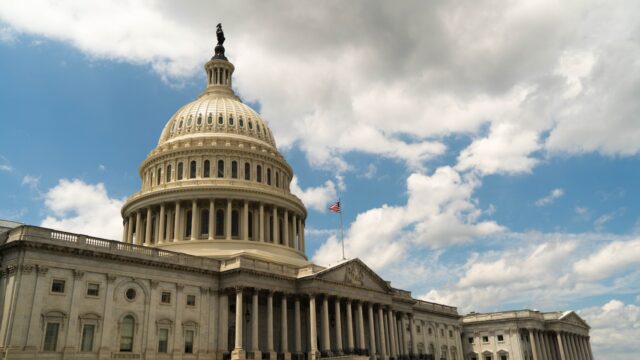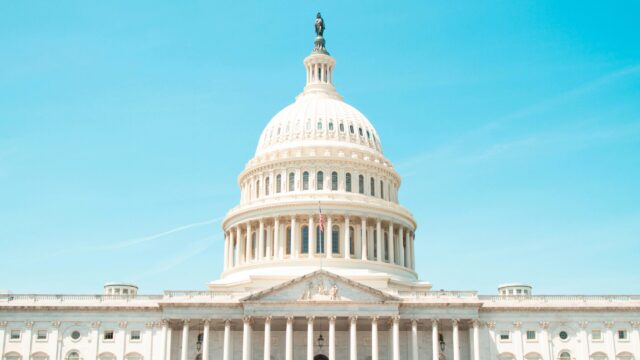Congress should increase FY25 funding to end HIV epidemic
April 2024

BCHC signed onto a letter – led by the Federal AIDS Policy Partnership (FAPP) and co-signed by 119 other organizations – urging the House and Senate Appropriations Committee to increase crucial funding for domestic HIV/AIDS programs.
Below are detailed domestic HIV and related programs funding requests to include in the FY2025 appropriations bills. A chart detailing each request as well as previous fiscal year funding levels for each program may be found on FAPP’s site.
Ending the HIV Epidemic Initiative
Over the last four fiscal years, on a bipartisan basis, Congress has appropriated additional funding for the Ending the HIV Epidemic Initiative, which sets the goal of reducing new HIV infections by 50% by 2025, and 90% by 2030.
We ask Congress to fund the Ending the HIV Epidemic Initiative by the amounts listed below in the following operating divisions in FY2025:
The Ryan White HIV/AIDS Program
An increase in funding could expand access to effective HIV care and treatment to more people living with HIV. When adjusted for inflation, Ryan White Program funding has not increased since 2001, and funding has slowly decreased since 2013 based on 2001 dollars. We urge Congress to fund the Ryan White HIV/AIDS Program at a total of $3.082 billion in FY2025, an increase of $510.8 million over FY2024, distributed in the following manner:
- Part A: $809 million
- Part B (Care): $520 million
- Part B (ADAP): $968.3 million
- Part C: $231 million
- Part D: $85 million
- Part F/AETC: $58 million
- Part F/Dental: $18 million
- Part F/SPNS: $34 million
- EHE Initiative: $358.6 million
CDC Prevention Programs
CDC HIV Prevention and Surveillance
The CDC’s Division of HIV Prevention leads federal efforts in developing innovative prevention strategies, working closely with state, local, and community partners to address racial and geographic disparities. Funding supports expanded, targeted programs, including non-traditional HIV testing such as at-home testing to reduce stigma.
We urge you to fund the CDC Division of HIV Prevention at $822.7 million in FY2025, an increase of $67 million over FY2024. This is in addition to the $395 million for EHE Initiative work within the Division.
Pre-Exposure Prophylaxis
In his FY2025 Budget Request, President Biden again called for a National PrEP Program to expand PrEP through providing medication to un- and under-insured individuals, as well as supporting and expanding PrEP programs across a variety of agencies. To increase equitable access to PrEP nationwide, we urge the Committee to support FY25 funding to continue work on a National PrEP Program and to expand PrEP access through other programs, including Ending the HIV Epidemic Initiative programs.
CDC Division of Adolescent and School Health (DASH)
CDC’s Division of Adolescent and School Health has provided funding for schools to increase access to health services, implement evidence-based sexual health education, and foster supportive environments for young people to learn. These programs have shown tremendous success in reducing risk factors related to HIV and other STIs, but only reach a small number of middle and high school students. To create a generation free of HIV, we must start in schools and ensure young people have the tools they need to make healthy decisions.
We urge you to fund the CDC Division of Adolescent and School Health at $100 million in FY2025, an increase of $61.9 million over FY2024.
CDC STD Prevention
Last year’s rescission of the remaining funding for the disease intervention specialist workforce expansion threatens the future of more than 1,000 full-time employees working to break transmission chains of STIs, HIV, viral hepatitis, and tuberculosis. Additional funding for the CDC’s Division of STD Prevention will allow STD programs to increase capacity, invest in disease intervention, monitor trends in STI cases throughout their jurisdictions, and quickly respond to new outbreaks. We are also requesting continuation of the funds begun in the FY2023 appropriations bill and continued in FY2024, including $20 million to move the grant year by one month, and $5 million to hold harmless grantee funding levels.
We urge you to fund the CDC Division of STD Prevention at $322.5 million in FY2025, an increase of $148.2 million over FY2024.
CDC Viral Hepatitis Prevention
The CDC Division of Viral Hepatitis (DVH) is the lead agency combating viral hepatitis at the national level by coordinating hepatitis education and technical assistance for providers and providing funding to the state and local health departments. DVH is currently funded at only $43 million–a debilitatingly small amount of funding. Now is the time to fully fund DVH and strengthen the public health infrastructure needed to respond to infectious diseases, particularly those caused and exacerbated by the nation’s opioid crisis. We also encourage Congress to enact President Biden’s proposal for a mandatory funded national initiative to eliminate Hepatitis C.
We urge you to fund the CDC DVH Division of Viral Hepatitis at $150 million in FY2025, an increase of $107 million over FY2024.
CDC Infectious Diseases and Opioid Epidemic Funding
Funding is also needed for the CDC to combat infectious diseases commonly associated with injection drug use in areas most impacted by the opioid crisis. Funding would provide a critical down payment for services needed to help stop the spread of opioid- related infectious diseases.
We urge you to fund the CDC’s Infectious Diseases and Opioid Epidemic program in FY2025 at $150, an increase of $127 million over FY2024.
CDC Division of Tuberculosis Elimination (DTBE)
The CDC’s Division of Tuberculosis Elimination (DTBE) spearheads the fight against TB in the U.S., providing support and guidance to state and local TB programs. To support DTBE in its essential functions, including research and supporting domestic TB programs, and to address the National Action Plan to Combat Multidrug-Resistant Tuberculosis (NAP), increased funding is imperative. This includes funding for a national prevention initiative, prioritizing high-risk individuals, and resources to address ongoing infrastructure challenges such as treatment shortages.
We urge you to fund the CDC Division of Tuberculosis Elimination at $225 million in FY2025, an increase of $88 million over FY2024.
Harm Reduction Programs
Unfortunately, the FY2024 omnibus retained a policy rider limiting federal funds for the purchase of sterile syringes, hindering the expansion of syringe service providers by state and local public health agencies.
We urge you to fund the SAMHSA Community Harm Reduction and Engagement Initiative at $50 million in FY2025 and to remove bill language restricting the use of federal funds for the purchase of syringes while also not adding additional restrictions.
HIV/AIDS Housing
The Department of Housing and Urban Development’s Housing Opportunities for People With AIDS (HOPWA) program is the only federal program that directly provides supportive and affordable housing for low-income people living with HIV. To end HIV in America, we must robustly fund the HOPWA program.
We urge you to fund the HOPWA program at least at $600 million in FY2025, an increase of $95 million over FY2024.
Minority HIV/AIDS Initiative (MAI)
The Minority AIDS Initiative (MAI), established two decades ago, aims to improve HIV-related health outcomes for racial and ethnic minorities and reduce disparities. SAMHSA’s MAI program provides tailored services, including prevention, treatment, and support for individuals at risk of mental illness and/or substance abuse, along with HIV testing and linkage services.
We urge you to fund the Minority HIV/AIDS Fund at $105 million, and SAMHSA’s MAI program at $160 million in FY2025, an increase of $48 million and $44 million over FY2024 levels, respectively. We also urge you to fund Minority AIDS Initiative programs across HHS agencies at $610 million in FY2025.
Bio-Preparedness Workforce Pilot Program
It is estimated that 80% of the counties in 14 Southern states where some of the highest numbers of new HIV infections are occurring have no experienced HIV clinicians, with the disparities being most significant in rural areas. We urge your committee to fund the Bio-Preparedness Workforce Pilot Program within HRSA. This program will ensure a robust workforce of healthcare professionals is available to provide ID and HIV services in health professional shortage areas with underserved patient populations and at certain federally funded facilities and clinics, including Ryan White HIV/AIDS clinics.
We urge you to fund the Bio-Preparedness Workforce Pilot Program at $50 million in FY 2025.
HIV/AIDS Research at the National Institutes of Health
Far-reaching AIDS research at the NIH supports innovative basic science for better drug therapies and behavioral and biomedical prevention interventions, which have saved and improved the lives of millions around the world. One area where investment in HIV research is showing its critical value is in developing a COVID-19 vaccine, where years of painstaking work by the NIH to develop HIV vaccines is now making possible the record-breaking timelines for the development of COVID-19 vaccines and other therapeutics.
The NIH Office of AIDS Research’s FY2025 Professional Judgment Budget identified promising unfunded research priorities, such as reducing incidence through vaccines, more effective treatments, cure research, addressing the relationship between HIV and aging, as well as HIV co-morbidities research involving opioid coepidemics, viral hepatitis, tuberculosis, and cancer. Without increases in HIV research funding, advances in these areas will be slowed or even stopped, research support for the EHE Initiative and the National HIV/AIDS Strategy for the United States will falter, and the early career researchers so critical to the future of HIV will move to other fields. While HIV treatment and prevention are the primary beneficiaries of HIV research, advances in basic medicine funded through HIV research at NIH have led to new vaccines, treatments, and medication for many other diseases such as cancer, Alzheimer’s, kidney disease, tuberculosis, and now COVID-19.
We urge you to fund HIV/AIDS research at the NIH at $3.953 billion for FY2025. This request is based on the FY2025 NIH HIV/AIDS Professional Judgment Budget.
Federal HIV/AIDS Coordination
ABAC is requesting increased funding for two important offices that coordinate the implementation of the NHAS and EHE activities. The White House Office of National AIDS Policy and the HHS Office of Infectious Disease and HIV/AIDS Policy both play an important role in developing and implementing government-wide HIV strategies, as well as coordinating efforts among the wide range of federal agencies working to end the HIV epidemic and the syndemics of STDs, hepatitis, TB, and overdoses.
We urge you to provide a total of $20 million for the Office of Infectious Disease and HIV/AIDS Policy and $3 million for the White House Office of National AIDS Policy in FY2025.
Sexual Health Programs
The Teen Pregnancy Prevention Program provides young people with evidence-informed or evidence-based information to prevent unintended pregnancies, HIV, and other STDs. As noted above, HIV and STDs disproportionately impact young people, so they must receive age-appropriate medically accurate, and complete information. This program is an important tool in our quest to end HIV and STDs.
We urge you to fund the Teen Pregnancy Prevention Program at $150.0 million in FY2025, an increase of $49 million over FY2024.
Despite decades of research that shows that “sexual risk avoidance” abstinence-only programs are ineffective at their sole goal of abstinence until marriage for young people, more than $2 billion has been spent on abstinence-only programs since its emergence in 1982. These programs withhold necessary and lifesaving information, reinforce gender stereotypes, often ostracize LGBTQIA+ youth, and stigmatize young people who are sexually active or survivors of sexual violence.
We urge you to eliminate funding for the failed and incomplete abstinence-only-until-marriage “Sexual Risk Avoidance Education” competitive grant program and the Title V “Sexual Risk Avoidance Education” state grant program in FY2025, which would render a $35 million savings based upon FY2024 funding levels.
The Title X program is the only dedicated federal family planning program and is a vital tool in fighting the HIV and STD epidemics in the United States. Title X-funded health centers provide millions of people with high-quality care—including contraceptive care, HIV and STD screening, STD treatment, cancer screening, and sexual health education—each year and are a particularly important lifeline for low-income women, especially women of color.
We urge you to fund Title X at $512 million in FY2025, an increase of $225.5 million over FY2024.
To treat the rising costs of new STI infections and address healthcare access issues, we request $200 million for a new demonstration project within the Bureau of Primary Health Care at HRSA to award grants to eligible public and private nonprofit clinics for STI clinical services, which will address staffing shortages, enhance training, and expand capacity. Testing and prompt treatment for bacterial STIs are the best tools to reduce STI rates in the US. However, there is currently no dedicated federal program to directly support high-quality and accessible STI clinical services. This demonstration project will provide long-overdue support for patients seeking care, and their public and nonprofit providers.
We urge you to fund a new STI clinical services demonstration project within HRSA at $200.0 million in FY2025.
SAMHSA HIV Block Grant
We urge you to include language, as was proposed in the President’s budget, that would modernize how states qualify to be eligible for the HIV set-aside of the Substance Abuse Block Grant (SABG).
Read the letter
Download now Read the letter

